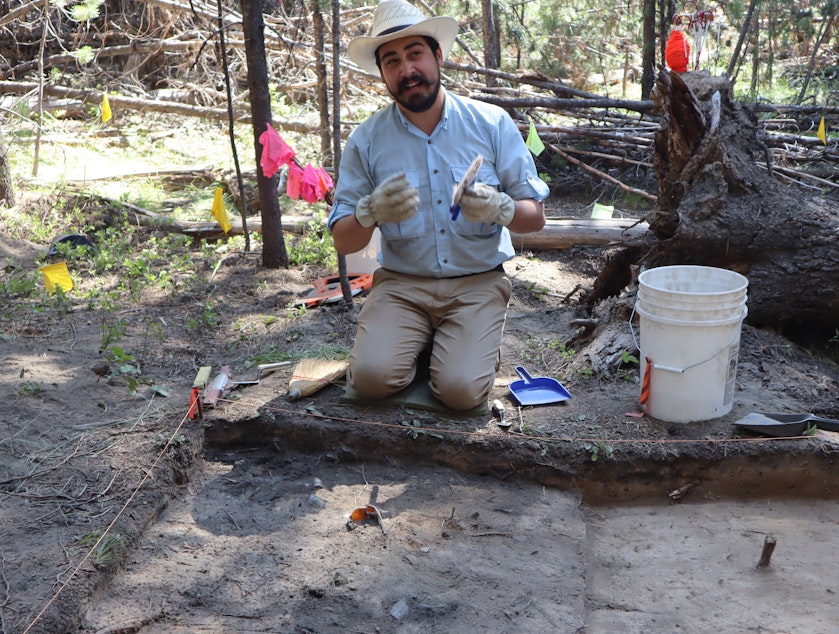Archaeologists on surprising trail of Japanese families who lived in vanished Oregon lumber company town

The classic black-and-white photos from early decades of the American West often fail to capture the diversity of the people who came here. Chinese migrants helped build the railroads and were big in gold mining. Basque people from Spain became known for sheep herding. The first Filipino cannery workers arrived around the turn of the last century. Now, Oregon archaeologists are on the surprising trail of Japanese families who lived in a now-vanished lumber company town.
The project promises to paint a fuller picture of who built the Pacific Northwest, which is a favorite research target of archaeologist Chelsea Rose, the director of the Southern Oregon University Laboratory of Anthropology. In her team's latest foray into Eastern Oregon, they are literally digging into timber history.
"The story of logging is a white man's narrative," Rose said. "You not only don't see Japanese, Chinese, all the other folks that were working on these kinds of operations, but you also don't see families. You don't see the women and children."
Which brings us to the ruins of the former Baker White Pine Mill and the company town that once surrounded it in rural Grant County, Oregon, roughly a century ago — 1912 to 1930, to be more precise.
A forest of spindly pine trees has regrown on the property northeast of Prairie City. But sharp eyes and metal detectors helped Rose and a team of professional archaeologists and volunteers identify spots to dig where workers' homes might have been.
Sponsored
The scene had all the hallmarks you might associate with archaeology. There were grid markers and shallow, square pits in the ground with people wielding trowels, brushes, buckets and sifting trays.
Working in the hot July sun, the researchers needed only to scrape down a few inches before they began to uncover remnants of domestic life. The bounty included a delicate ring with inlaid gemstone and lots of shards of Western-style export Japanese porcelain, some with distinctive dragon and cloud motifs.
"We are on an industrial site and we're finding doll arms, marbles and tea sets. That really brings home this idea that families were part of these early industries in these remote areas," Rose said during a lunch break. "We need to broaden our understanding of what that looks like."
The sawmill ruin and vanished company town are an unmarked U.S. Forest Service site now. Blue Mountain Ranger District archaeologist Katee Withee said the Forest Service might eventually install interpretive signs or add the site to an auto tour. When Withee was growing up in Eastern Oregon, she said she had no idea Japanese workers a century ago built railroad spurs, cooked in logging camps and hired on with area mills.
"It makes sense once you look at the Census records, right," Withee said. "But that definitely wasn't something we were highlighting in eighth grade history."
Sponsored
Records from the 1910, 1920 and 1930 censuses included the names and occupations of dozens of immigrants and Japanese American families who lived in the township around the Baker White Pine Mill. They weren't farmers, that being a common assumption -- and often a correct presumption -- of what this group did a century ago.
The info coming out of the archaeological dig was sufficiently exciting and novel to entice Japanese American Museum of Oregon interim deputy director Mark Takiguchi and the museum's research coordinator James Rodgers to drive all the way from Portland to observe.
"This is so cooollll!" Takiguchi burst out after walking around the large site.
"I'm really interested personally in finding out where they went," Takiguchi said. "What was the next chapter after this chapter closed? Where in Oregon or Idaho did they travel? What were the stories? I think we have some really exciting leads of living people we can pursue."
Those would be descendants probably three generations removed from the names on the old census rolls.
Sponsored
"We're going to bring back some really exciting stories to our community," Takiguchi vowed.
The genealogical sleuthing will happen simultaneously with the examination of thousands of artifacts collected from the lumber mill dig. The physical items were hauled back to the lab at Southern Oregon University in Ashland in late July. So far, Rose said the researchers have been unable to link any artifacts or specific home sites to identifiable families, but that is a key goal.
NOTE: After our original story published, a listener asked for more detail on why the company town had vanished in the first place.
The reason? The successive blows came from the closure of the Baker White Pine lumber mill circa 1930 and the shutdown of the rail line that served the mill and community a few years later. Rose said she suspects the lumber company or the former residents deconstructed the worker housing and carted off the salvaged wood to reuse somewhere else. That would explain why there are practically no standing remnants of an old ghost town, and why the tools of archaeology are needed to suss out which buildings stood where.
"Without the mill, and with the abandonment of the railroad, there would be little reason or the ability for anyone to stay on in the associated community," added archaeologist Eric Gleason, another member of the research and excavation team.
Copyright 2022 Northwest News Network




